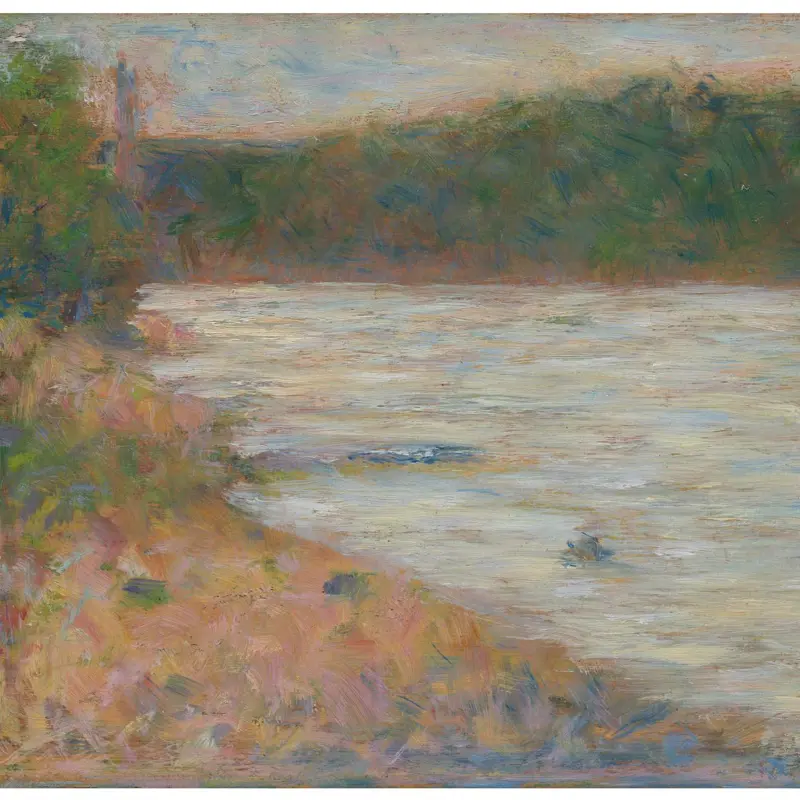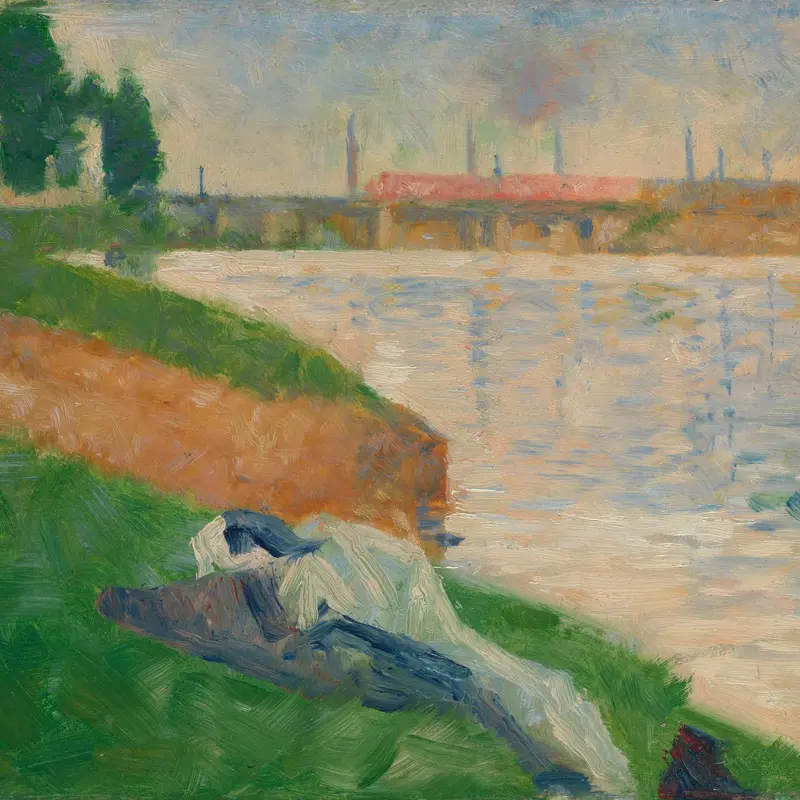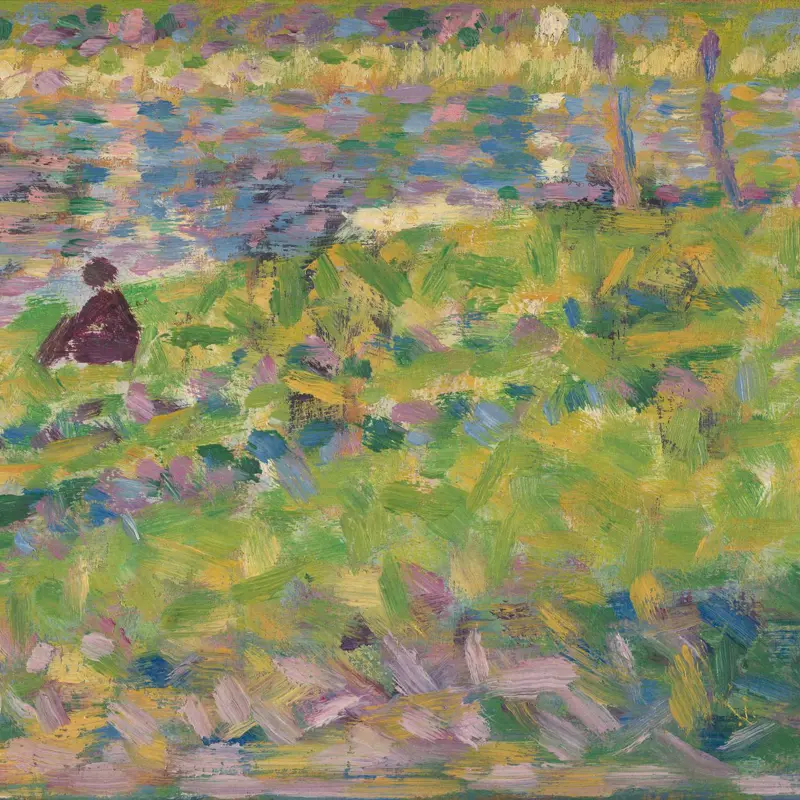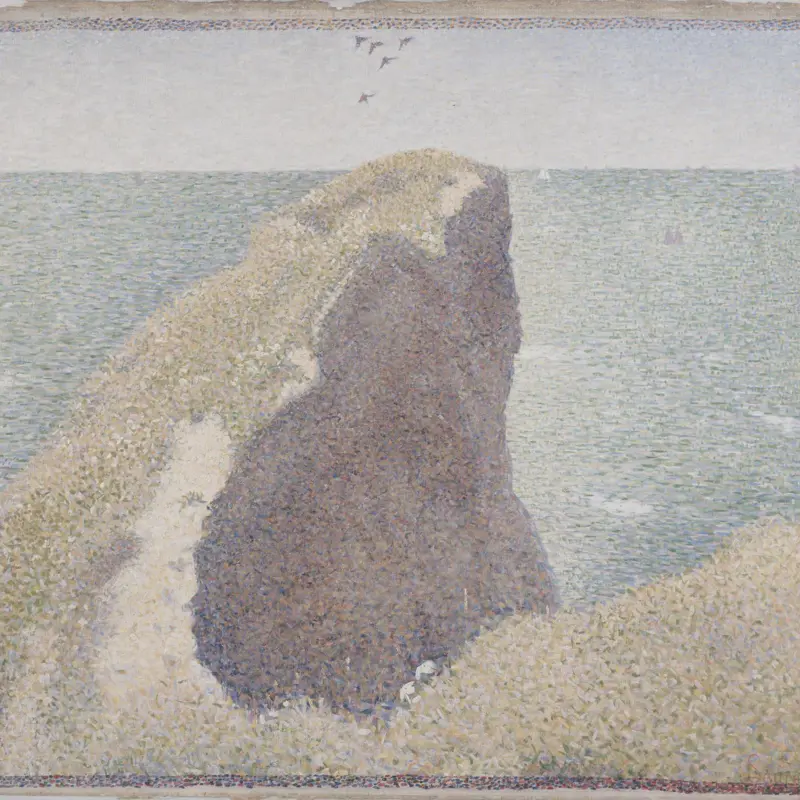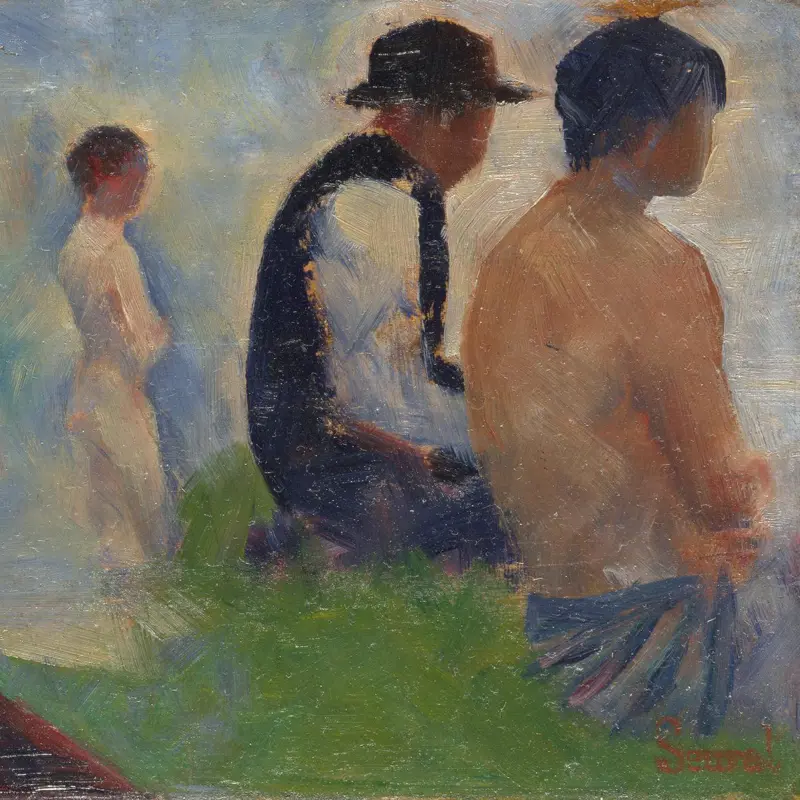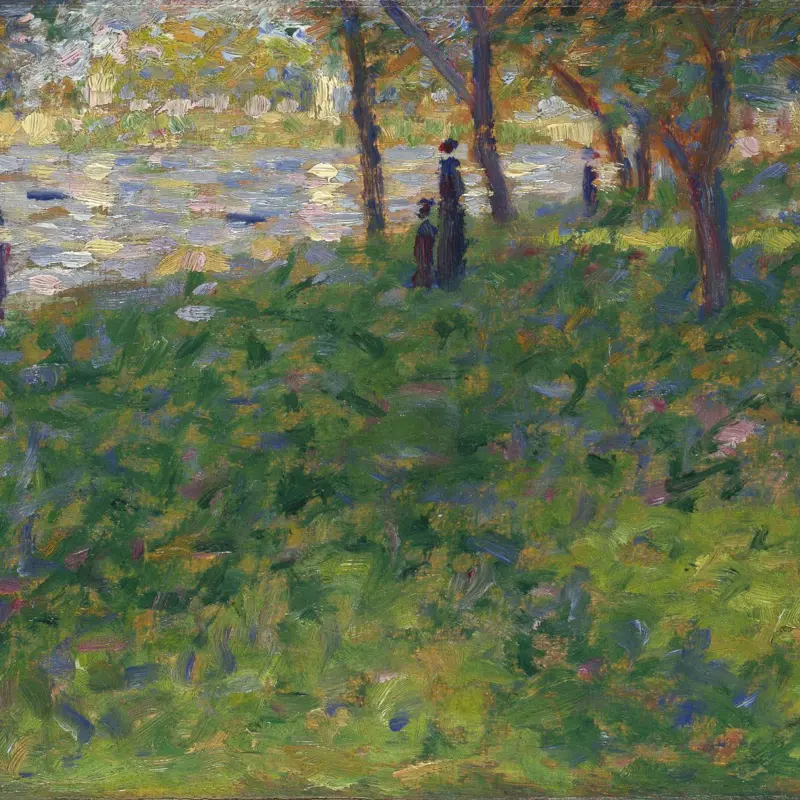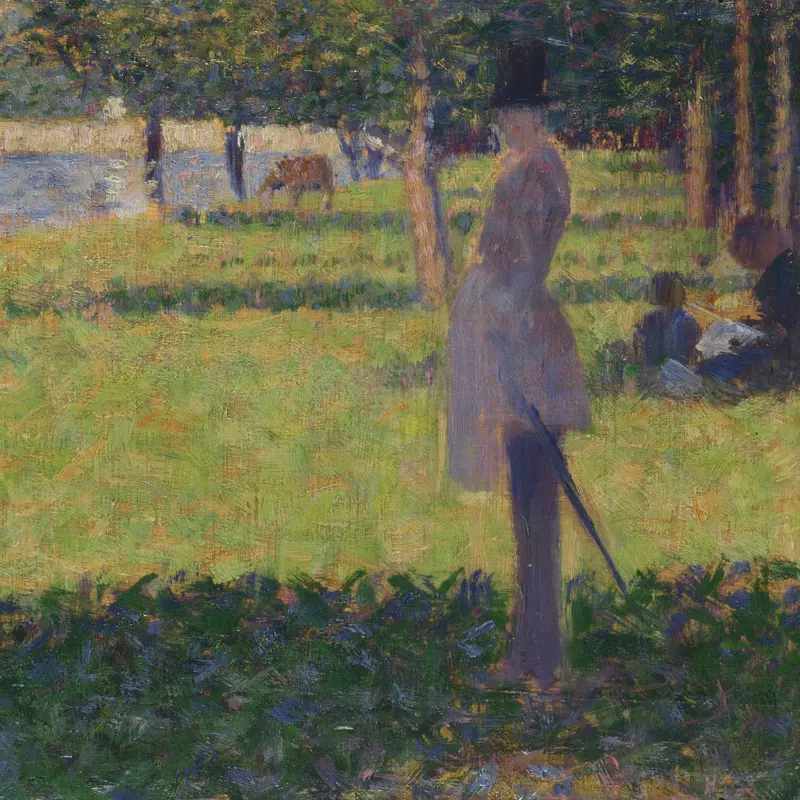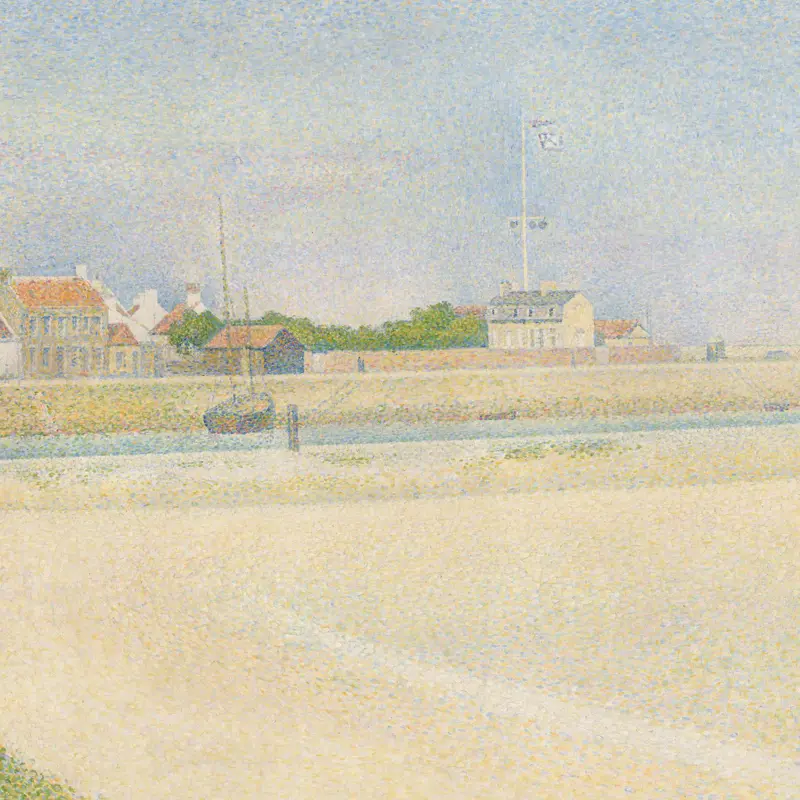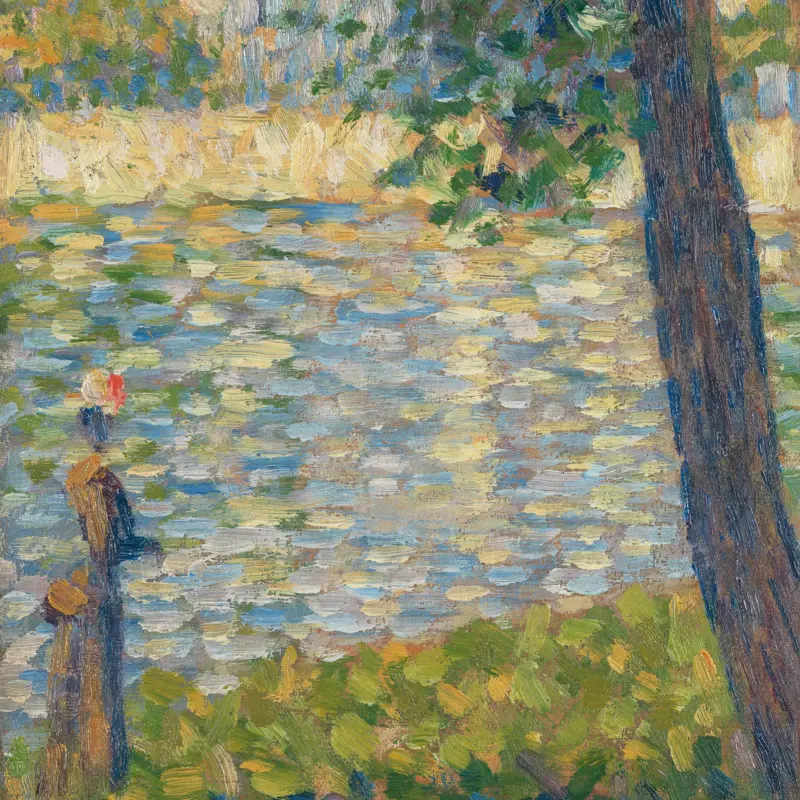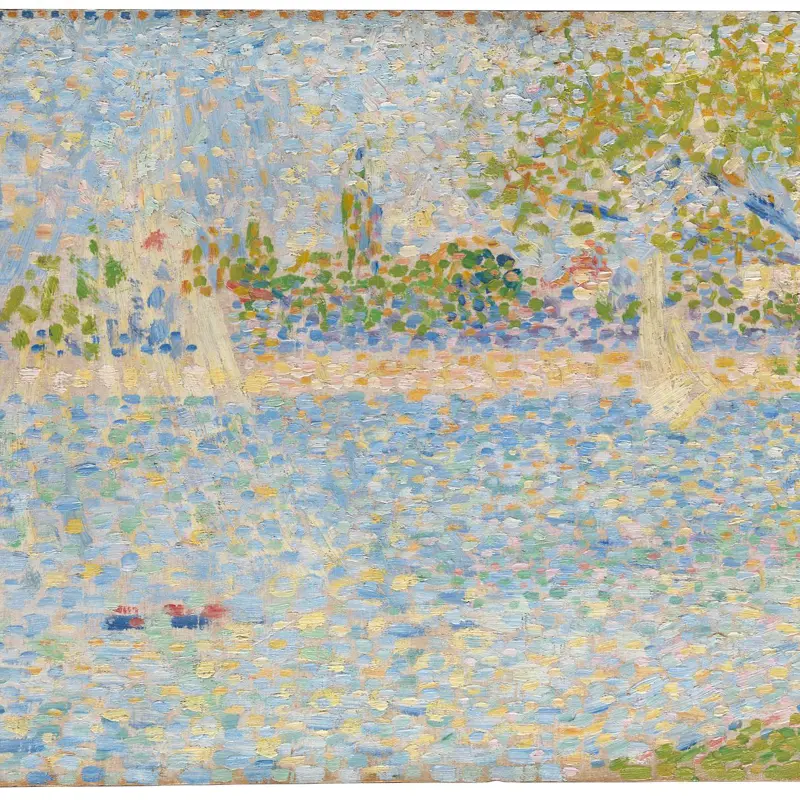Georges Seurat, 'Bathers at Asnières', 1884
About the work
Overview
This large picture was Seurat’s first major composition, painted when he had not yet turned 25. He intended it to be a grand statement with which he would make his mark at the official Salon in the spring of 1884, but it was rejected.
Several men and boys relax on the banks of the Seine at Asnières and Courbevoie, an industrial suburb north-west of central Paris. Shown in profile, they are as immobile as sculptures and each seems absorbed in his own thoughts, neither engaging with each other nor with us. Suffused with bright but hazy sunlight, the entire scene has an almost eerie stillness to it, as if time has been suspended and all movement temporarily frozen. In the background there is a railway bridge that partly hides a parallel road bridge, as well as the chimneys of the gas plant and factories at Clichy, where some of the men may work.
Audio description
Listen to an audio description of Georges Seurat's 'Bathers at Asnières'
Transcript
This is a description of 'Bathers at Asnières' by Georges Seurat, painted in 1884. It is an enormous landscape, 2 metres high by 3 metres wide, oil on canvas in an ornately patterned gold frame.
The painting features seven seemingly male figures, some dressed, some in swim wear. Five are lounging on the bank of the river Seine on a warm, sunny day, the other two in the water.
The top third of the canvas is light blue sky with trees to the left and right. It is flecked with dabs of white, either to suggest clouds or to give the sky an unfocused appearance. The lower two thirds of the painting are divided diagonally from top left to bottom right. On the left, the grassy riverbank, and on the right, the river. The whole scene has been painted with a variety of visible brushstrokes. The array of dabs, flicks, and sweeps of paint give the scene a shimmering, slightly hazy quality.
In the far distance, on the right of the horizon, is a cluster of large, white and pink-orange buildings. Their tall, thin chimneys, one of which emits a large cloud of grey smoke, identify them as factories. To the left of the horizon runs a bridge – a low white plume of steam suggesting a train travelling across it.
One figure dominates the scene in the centre, sitting on the riverbank trailing his legs in the water. He is in profile, facing right, shoulders slumped. He wears just a pair of light red shorts. His skin is a pale whitish-pink. He has ear-length reddish-brown hair, his face in shadow, only his mouth visible by the profile of his lips. His large Roman nose gives him the appearance of an old emperor depicted on a coin. But the clothes that lie on the grass around him give the impression of a work uniform: a white coat, brown shoes and trousers, and a cream straw hat. Could he be a factory worker on his break?
Another more neatly folded pile of the same kind of clothing lies the grass on the far left edge of the painting, perhaps belonging to one of the two figures standing in the water. One has his back to us, almost submerged to his shoulders. The other, nearest to us, stands waist high, giving a glimpse of his red shorts. He wears a reddish-orange hat, the low brim almost completely covering his black hair. Seurat has picked out the shadow on the back of the hat with blue dots, a brief appearance of the technique that would come to be called pointillism. The figure, more boy than man, cups his hands to his mouth as if calling to someone.
Moving back onto the grassy bank on the left, three figures in the distance sit hugging their knees or sprawl out.
In the bottom left foreground, a fourth figure, much closer, lies on his side, his back to us. His head is to the left, propped up on his hand. He wears a white coat, dark trousers and boots, and a black bowler hat. A small reddish-brown dog, lies at his back, looking at the water.
The river is populated by five boats. Three have white sails while two are rowed. One of these is a long, slim racing boat, traveling to the right, rowed by a figure bent double with effort. The other moves left at a seemingly more leisurely pace, a man in a straw hat punting. The French flag hangs limp at the front of the boat - its passengers a man in a black coat and top hat, and a woman partly hidden behind a white sun parasol. Their clothes mark them out as bourgeois, middle-class, but they are so much smaller, and seem insignificant compared to the central figure sitting on the riverbank. He is the focus of Seurat’s painting - an anonymous working-class man, at rest, depicted on a monumental scale.
In the bottom left-hand corner of the painting, the artist has signed his last name, “Seurat”.
Key facts
Details
- Full title
- Bathers at Asnières
- Artist
- Georges Seurat
- Artist dates
- 1859 - 1891
- Date made
- 1884
- Medium and support
- Oil on canvas
- Dimensions
- 201 × 300 cm
- Inscription summary
- Signed
- Acquisition credit
- Bought, Courtauld Fund, 1924
- Inventory number
- NG3908
- Location
- Room 44
- Collection
- Main Collection
- Frame
- 19th-century French Frame
Provenance
Additional information
Text extracted from the ‘Provenance’ section of the catalogue entry in Martin Davies, with additions and some revisions by Cecil Gould, ‘National Gallery Catalogues: French School: Early 19th Century, Impressionists, Post-Impressionists, etc.’, London 1970 and supplemented by Isobel Muir; for further information, see the full catalogue entry.
Exhibition history
-
2018Courtauld Impressionists: From Manet to CézanneThe National Gallery (London)17 September 2018 - 20 January 2019
Bibliography
-
1884Trublot, 'L'exposition des indépendants', Cri du peuple, 1884
-
1884E. Jacques, 'Salon des Indépendants', L'Intransigeant, 1884
-
1884P. de Katow, 'Le Salon des Artistes Indépendants', Gil Blas, 1884
-
1884R. Marx, 'L'Exposition des Artistes Indépendants', <i>Le Voltaire</i>, 16 May 1884
-
1886'The French Impressionists', The Critic, 1886
-
1886'The Impressionists', The Sun, 1886
-
1890J. Christophe, 'Notice sur Georges Seurat (le peintre)', Les Hommes d'aujourd'hui, VIII/368, 1890
-
1891É. Verhaeren, 'Georges Seurat', La Société nouvelle, VII, 1891
-
1891G. Kahn, 'Georges Seurat', L'Art Moderne, 1891
-
1892C. Saunier, 'L'art nouveau: I. Camille Pissarro', La Revue indépendante, 1892, pp. 30-40
-
1899P. Signac, 'D'Eugène Delacroix au néo-impressionnisme', Revue blanche, 1899
-
1904A.J. Meier-Graefe, Entwicklungsgeschichte der modernen Kunst, München 1904
-
1905F. Lepeseur, 'Anarchie Artistique', La Renovation Esthetique, 1905, pp. 91-6
-
1908A.J. Meier-Graefe, Modern Art, Being a Contribution to a New System of Aesthetics, London 1908
-
1911C.H. Caffin, The Story of French Painting, New York 1911
-
1911A. Chervachidze, 'Georges Seurat', Apollon, 1911
-
1912L. Cousturier, 'Georges Seurat', L'Art décoratif, 174, 1912
-
1918J. Sacs, 'En Seurat, el Lluminisme i els pobres lluministes', Vell i Nou, 1, 1918
-
1920G. Coquiot, Les Indépendants 1884-1920, Paris 1920
-
1920R. Fry, Vision and Design, London 1920
-
1920C. Marriott, Modern Movements in Painting, London 1920
-
1920A. Salmon, 'Georges Seurat', The Burlington Magazine, XXXVII/210, 1920
-
1921L. Cousturier, Georges Seurat, Paris 1921
-
1922A. Lhote, Georges Seurat, Rome 1922
-
1923W. Pach, Georges Seurat, New York 1923
-
1923W. Pach, 'Seurat', Arts, 1923
-
1924G. Coquiot, Des peintres maudits, Paris 1924
-
1924G. Coquiot, Seurat, Paris 1924
-
1924W. Pach, The Masters of Modern Art, New York 1924
-
1924G. Kahn, 'Au temps de pointillisme', Mercure de France, CLXXI, 1924, pp. 5-22
-
1924F. Fels, 'Chronique artistique - Seurat entre au Louvre', Nouvelles Littérataires, 1924
-
1925J.B. Manson, 'La Baignade', Apollo, 1925, pp. 299-300
-
1925O. Sitwell, 'The Courtauld Collection', Apollo, 1925, pp. 63-9
-
1926Bernheim-Jeune, Seurat, Paris 1926
-
1926L. Cousturier, Seurat, Paris 1926
-
1926R. Fry, Transformations. Critical and Speculative Essays on Art, London 1926
-
1926Tate Gallery, Tate Gallery: Catalogue of Modern Foreign School, London 1926
-
1926Anon., 'Art Purchases for the Nation: The Courtauld Fund: Modern Foreign Paintings', Morning Post, 1926
-
1926F. Fénéon, 'Sur Georges Seurat', Bulletin de la vie artistique, 1926
-
1926J.B. Manson, 'The Courtauld Collection', Apollo, 1926, pp. 92-6
-
1926W. McCance, 'The Courtauld Collection', Spectator, 1926
-
1926O. Sitwell, 'Les Poseuses', Apollo, 1926
-
1926R.R. Tatlock, 'The Courtauld Trust', The Burlington Magazine, XLVIII, 1926, pp. 56-65
-
1926R.R. Tatlock, 'The Tate Gallery. Courtauld Collection', Daily Telegraph, 1926
-
1926'Art Exhibitions: Courtauld Collection', The Times, 1926
-
1926R. Fry, 'Seurat', The Dial, 1926, pp. 227-8
-
1927C. Bell, Landmarks in Nineteenth-Century Painting, London 1927
-
1927J. Laver, French Painting and the Nineteenth Century, New York 1927
-
1927É. Verhaeren, Sensations, Paris 1927
-
1927E. Waldmann, Die Kunst des Realismus und des Impressionismus im 19 Jahrhundert, Berlin 1927
-
1927R.H. Wilenski, The Modern Movement in Art, London 1927
-
1927C. Roger-Marx, 'Seurat', Gazette des beaux-arts, 1927
-
1928J.-E. Blanche, De Gauguin à la Revue nègre, Paris 1928
-
1928B. Hintze, Modern konst, Stockholm 1928
-
1928G. Kahn, Dessins de Georges Seurat, Paris 1928
-
1928J. Meier-Graefe, 'Julius: Die Franzosen in der Tate Gallery', Cicerone, 12, 1928, pp. 389-97
-
1928R.A. Parker, 'The Drawings of Georges Seurat', International Studio, 1928, pp. 20-1
-
1928W. George, 'Seurat et le divisionnisme', in Les Albums d'Art Druet, Paris 1928
-
1930J.-E. Blanche, Les arts plastiques, Paris 1930
-
1930E. Fagg, Modern French Masters: An Introduction and Complete Handbook to the Modern Foreign Work in the National Gallery, London 1930
-
1930J.B. Manson, The Tate Gallery, London 1930
-
1930T. Bernard, 'La Baignade', La Renaissance des Arts, 1930, pp. 2-42
-
1930H.S. Ede, 'La peinture française à la National Modern Foreign Gallery de Londres', Cahiers d'Art, VII, 1930, pp. 355-60
-
1930K. Niehaus, 'Georges Seurat', Elsevier's Geïllustreerd Maandschrift, XL, 1930
-
1931R. Rey, La renaissance du sentiment classique, Paris 1931
-
1931C. Roger-Marx, Seurat, Paris 1931
-
1931J.F. Van Deene, 'Georges Seurat', Maandblad voor Beeldende Kunsten, 1931
-
1932B.E. Werner, 'Seurat', Die Kunst, 1932
-
1933F. Walter, 'Du paysage classique au surréalisme: Seurat', Revue de l'art, 1933, pp. 165-76
-
1934P. Jamot, La peinture en France, Paris 1934
-
1934P. Signac, 'Le néo-impressionisme: Documents', Gazette des beaux-arts, XI, 1934, pp. 49-59
-
1935D.C. Rich, Seurat and the Evolution of La Grande Jatte, Chicago 1935
-
1935R.H. Wilenski, The Modern Movement in Art, London 1935
-
1936S. Rocheblave, La peinture française au XIXe siècle, Paris 1936
-
1936J. Hélion, 'Poussin, Seurat et le double rythme', Axis, 1936, pp. 9-17
-
1936M.A. Leblond, 'Commémoration Seurat (compte rendu d'Exposition)', La Vie, 1936
-
1937J. Hélion, 'Poussin, Seurat, and Double Rhythm', in M. Evans (ed.), The Painter's Object, London 1937, pp. 94ff
-
1938C. Zervos, Histoire de l'art contemporain, Paris 1938
-
1939L. Venturi, Les archives de l'impressionnisme, Paris 1939
-
1941R.J. Goldwater, 'Some Aspects of the Development of Seurat's Style', Art Bulletin, 1941, pp. 117-30
-
1941B. Nicolson, 'Seurat's La Baignade', The Burlington Magazine, LXXIX/474, 1941, pp. 140-6
-
1943J. Rewald, Georges Seurat, New York 1943
-
1944F. Maret, Les peintres luministes, Brussels 1944
-
1944L. Venturi, 'The Art of Seurat', Gazette des beaux-arts, 1944, pp. 421-30
-
1944J.C. Webster, 'The Technique of Impressionism: A Reappraisal', College Art Journal, IV/1, 1944, pp. 3-23
-
1945T.W. Earp, French Painting, London 1945
-
1945J. de Laprade, Georges Seurat, Monaco 1945
-
1946J. Rewald, History of Impressionism, New York 1946
-
1946J. Rewald, Seurat, New York 1946
-
1946H. Huth, 'Impressionism Comes to America', Gazette des beaux-arts, 1946
-
1946J. Rothenstein, 'The Tate Gallery', Studio, 1946, pp. 161-76
-
1947E. d'Ors, Georges Seurat, Madrid 1947
-
1947G. Seligman, The Drawings of Seurat, New York 1947
-
1947J. Bouchot-Saupique, 'Trois dessins de Seurat', Bulletin des Musées de France, 1947
-
1947P. Signac, 'Fragments du journal, 3rd April 1900', Arts de France, pp. 11-2, 98
-
1947H. Hildebrandt, 'Neoimpressionisten, XI, Georges Seurat', Aussaat: Zeitschrift für Kunst und Wissenschaft, III-IV, 1947, pp. 100-4
-
1948J. Rewald, Seurat, Paris 1948
-
1949J. Rewald, Seurat, Paris 1949
-
1949J. Rothenstein, Modern foreign pictures in the Tate Gallery, London 1949
-
1949R.H. Wilenski, Seurat, London 1949
-
1949J. Rewald, 'Extraits du journal inédit de Paul Signac, I', Gazette des beaux-arts, 1949
-
1950H. Jedding, Seurat, Milan 1950
-
1950L. Venturi, Impressionists and Symbolists, London 1950
-
1950D. Wild, Moderne Malerei, Zurich 1950
-
1950R. Longhi, 'Un disegno per la Grande Jatte e la cultura formale di Seurat', Paragone, 1950, pp. 40-3
-
1951R. Cogniat, Seurat, Paris 1951
-
1951J. de Laprade, Seurat, Paris 1951
-
1953G. Bazin, L'époque impressionniste: Avec notices biographiques, Paris 1953
-
1953J. Cassou, Les impressionistes et leur époque, Paris 1953
-
1953L. Venturi, De Manet à Lautrec, Paris 1953
-
1953'Notable Works of Art Now on the Market', The Burlington Magazine, XCV/609, 1953
-
1954D. Cooper, The Courtauld Collection: A Catalogue and Introduction, London 1954
-
1954R. Gaffé, Introduction à la peinture française. De Manet à Picasso, Paris 1954
-
1956J. Rewald, Post-Impressionism from Van Gogh to Gauguin, London 1956
-
1957P. Courthion, Paris des temps nouveaux: De l'impressionnisme à nos jours, Geneva 1957
-
1957P. Bonnet, 'Seurat et le néo-impressionisme', Le Crocodile: bulletin de l'Association générale de l'internat des Hospices civils de Lyon, IV, 1957, pp. 6-22
-
1958R.L. Herbert, 'Seurat and Jules Chéret', Art Bulletin, XL/2, 1958, pp. 156-8
-
1958R.L. Herbert, 'Seurat in Chicago and New York', The Burlington Magazine, C/662, 1958, pp. 149-52
-
1958W.I. Homer, 'Seurat's Formative Period: 1880-1884', The Connoisseur, 1958, pp. 58-62
-
1958M. Schapiro, 'New Light on Seurat', Art News, 1958
-
1959R. Alley, Tate Gallery Catalogues: The Foreign Paintings, Drawings and Sculpture, London 1959
-
1959H. Dorra and J. Rewald, Seurat: L'oeuvre peint; biographie et catalogue critique, Paris 1959
-
1959S. Lövgren, The Genesis of Modernism: Seurat, Gauguin, Van Gogh and French Symbolism in the 1880's, Stockholm 1959
-
1959R.L. Herbert, 'Seurat and Emile Verhaeren: Unpublished Letters', Gazette des beaux-arts, 1959, pp. 315-28
-
1959R.L. Herbert, 'Seurat and Puvis de Chavannes', Yale University Art Gallery Bulletin, 1959, pp. 23-9
-
1959W.I. Homer, 'Notes on Seurat's Palette', The Burlington Magazine, CI/1886, 1959, pp. 192-3
-
1960M. Ayrton, 'Painting of the Month, Une Baignade, Asnières', The Listener, 1960, pp. 660-2
-
1960R.L. Herbert, 'A Rediscovered Drawing for Seurat's "Baignade"', The Burlington Magazine, CII/689, 1960, pp. 368-70
-
1961C. de Hauke, Seurat et son oeuvre, Paris 1961
-
1962R.L. Herbert, Seurat's Drawings, New York 1962
-
1962W.S. Meadmore, Lucian Pissaro: Un coeur simple, London 1962
-
1962R.L. Herbert, 'A Newly Discovered Drawing for Seurat's Bather', Yale University Art Gallery Bulletin, 1962, pp. 36-42
-
1964W.I. Homer, Seurat and the Science of Painting, Cambridge MA 1964
-
1965P. Angrand, La naissance des artistes indépendants 1884, Paris 1965
-
1965A. Boime, 'Seurat and Piero della Francesca', Art Bulletin, XLVII/2, 1965, pp. 265-71
-
1968R.L. Herbert, Neo-Impressionism (exh. cat. Solomon R. Guggenheim Museum, February - April 1968), New York 1968
-
1970Davies, Martin, and Cecil Gould, National Gallery Catalogues: French School: Early 19th Century, Impressionists, Post-Impressionists etc., London 1970
-
1970J.U. Halperin, Oeuvres plus que completes. Félix Fénéon, Geneva 1970
-
1976K. Clark, Landscape into Art, London 1976
-
1980J.U. Halperin, Félix Fénéon and the Language of Art Criticism, Ann Arbor 1980
-
1980J. House, 'Meaning in Seurat's Figure Paintings', Art History, III, 1980, pp. 345-56
-
1981I. Danielewicz, 'Puvis de Chavannes: Entre la tradition et la modernité', Bulletin du Musée National de Varsovie, XXII/2-3, 1981, pp. 37-51
-
1982H. Macandrew and K. Andrews, 'A Saenredam and a Seurat for Edinburgh', The Burlington Magazine, CXXIV/957, 1982, pp. 752-5
-
1983M. Wilson, French Painting after 1800, London 1983
-
1983M. Wilson, The Impressionists, Oxford 1983
-
1983R. Herz-Fischler, 'An Examination of Claims Concerning Seurat and the Golden Number', Gazette des beaux-arts, CI, 1983, pp. 109-12
-
1984E. Franz and B. Growe, Seurat's Drawings, Boston 1984
-
1985T.J. Clark, The Painting of Modern Life: Paris in the Art of Manet and His Followers, New York 1985
-
1985R. Thomson, Seurat, Oxford 1985
-
1985P. Collier, 'Nineteenth-Century Paris: Vision and Nightmare', in E. Timms and D. Kelley (eds), Unreal City: Urban Experience in Modern European Literature and Art, Manchester 1985, pp. 24-44
-
1987J. Gage, 'The Technique of Seurat: A Reappraisal', Art Bulletin, LXIX/3, 1987, pp. 448-54
-
1987A. Lee, 'Seurat and Science', Art History, 1987, pp. 203-26
-
1988J.U. Halperin, Félix Fénéon: Aesthete Anarchist in Fin-de-Siècle Paris, New Haven 1988
-
1989O. Bätschmann, Entfernung der Natur, Cologne 1989
-
1989P. Hill and R. Keynes, Lydia and Maynard: Letters of Lydia Lopokova and John Maynard Keynes, London 1989
-
1989R. Huyalté, Un siècle d'art moderne: L'histoire du Salon des Indépendants 1884-1984, Paris 1989
-
1989S. Hollis-Clayton, 'The Family and the Father: The Grande Jatte and Its Absences', Museum Studies, XIV/2, 1989, pp. 155-72
-
1990M. Kemp, The Science of Art: Optical Themes in Western Art from Brunelleschi to Seurat, London 1990
-
1990A. Madeleine-Perdrillat, Seurat, New York 1990
-
1990F. Ratliff, Paul Signac and Colour in Neo-Impressionism, New York 1990
-
1991A. Distel, Seurat, Paris 1991
-
1991J.L. Ferrier, L'aventure de l'art au XIXe siècle, Paris 1991
-
1991M.F. Zimmermann, Seurat and the Art Theory of His Time, Antwerp 1991
-
1991L. Nanteuil, 'Seurat: Une certaine révolution', Connaissance des arts, 470, 1991, pp. 36-43
-
1991W.H. Robinson, 'Puvis de Chavanne's Summer and the Symbolist Avant-Garde', Bulletin of the Cleveland Museum of Art, LXXVIII/1, 1991
-
1991R.L. Herbert, Seurat (exh. cat. Galeries Nationales du Grand Palais, 9 April - 12 August 1991; Metropolitan Museum of Art, 24 September 1991 - 12 January 1992), Paris 1991
-
1991R. Kendall, Van Gogh to Picasso: The Berggruen Collection at the National Gallery (exh. cat. The National Gallery, 16 January - 21 April 1991), London 1991
-
1992T. Parsons, Post-Impressionism: The Rise of Modern Art, London 1992
-
1992P. Smith, 'Missing the Point', Art History, XV/4, 1992, pp. 541-6
-
1993F.F. Frascina et al., Modernity and Modernism: French Painting in the Nineteenth Century, New Haven 1993
-
1993P. Mainardi, The End of the Salon: Art and the State in the Early 3rd Republic, Cambridge 1993
-
1994J. House, Impressionisim for England: Samuel Courtauld as Patron and Collector, London 1994
-
1994E. Langmuir, The National Gallery Companion Guide, London 1994
-
1994T. Matthews, 'Sex and the occult in Symbolist art and literature', in P. Collier and R. Lethbridge (eds), Artistic Relations: Literature and the Visual Arts in Nineteenth Century France, New Haven 1994, pp. 264-77
-
1994O. Sitwell, 'The Courtauld Collection', in J. House, Impressionism for England: Samuel Courtauld as Patron and Collector, London 1994, pp. 241-3
-
1994W. McCance, 'The Courtauld Collection', in J. House, Impressionism for England: Samuel Courtauld as Patron and Collector, London 1994
-
1994R. Fry, 'The Courtauld Fund', in J. House, Impressionism for England: Samuel Courtauld as Patron and Collector, London 1994, pp. 244-5
-
1995A. Danto, 'Men Bathing, 1883: Eakins and Seurat. Both Subverted What They Believed Was the Task of Art', ARTNews, XCIV/3, 1995, pp. 95-6
-
1995M.F. Zimmermann, 'Die "Erfindung" Pieros und seine Wahlverwandtschaft mit Seurat: Piero della Francesca and His Legacy', Studies in the History of Art, 1995, pp. 268-301
-
1996R. Brettell, 'Thomas Eakins and the Male Nude in French Vanguard Painting 1850-1890', in D. Bolger and S. Cash (eds), Thomas Eakins and the Swimming Picture, Fort Worth 1996, pp. 80-97
-
1997D. Bomford, Conservation of Paintings, London 1997
-
1997P. Smith, Seurat and the Avant-Garde, New Haven 1997
-
1997J. Leighton and R. Thomson, Seurat and the Bathers, (exh. cat. The National Gallery, 2 July - 28 September 1997), London 1997
-
1998D. Goodway (ed.), Herbert Read Reassessed, Liverpool 1998
-
2000E. Balas, 'A Contribution Towards the Understanding of Seurat's Late Works', Gazette des beaux-arts, CXLII/136, 2000, pp. 155-8
-
2001
C. Baker and T. Henry, The National Gallery: Complete Illustrated Catalogue, London 2001
-
2001R.L. Herbert, Seurat: Drawings and Paintings, New Haven 2001
-
2003J. Kirby et al., 'Seurat's Painting Practice: Theory, Development and Technology', National Gallery Technical Bulletin, XXIV, 2003, pp. 4-37
-
2005D. Lobstein, 'Un salon de Babel: La première exposition de la Société des artistes indépendants', La Revue du Musée d'Orsay, 20, 2005, pp. 38-51
-
2005R. Thomson, 'Seurat et la IIIe République: Opposant, caricaturiste ou supporter?', La Revue du Musée d'Orsay, 21, 2005, pp. 6-25
-
2006M. Frensch (ed.), Seurats Brücke: Vom Impressionismus zur Moderne, Schaffhausen 2006
-
2006C. Riopelle, Manet to Picasso, London 2006
-
2007J. Hauptman, Georges Seurat: The Drawings (exh. cat. Museum of Modern Art, 28 October 2007 - 7 January 2008), New York 2007
-
2007T.J. Clark, 'The Environs of Paris', in J. House, Critical Readings in Impressionism and Post-Impressionism: An Anthology, Berkeley 2007
-
2008M. Young, 'Heroic Indolence: Realism and the Politics of Time in Raffaëlli's "Absinthe Drinkers"', Art Bulletin, XC/2, 2008, pp. 235-59
-
2008M.F. Bocquillon, Georges Seurat, Paul Signac, e i neoimpressionisti (exh. cat. Palazzo Reale (Milan), 10 October 2008 - 25 June 2009), Milan 2008
About this record
If you know more about this work or have spotted an error, please contact us. Please note that exhibition histories are listed from 2009 onwards. Bibliographies may not be complete; more comprehensive information is available in the National Gallery Library.

